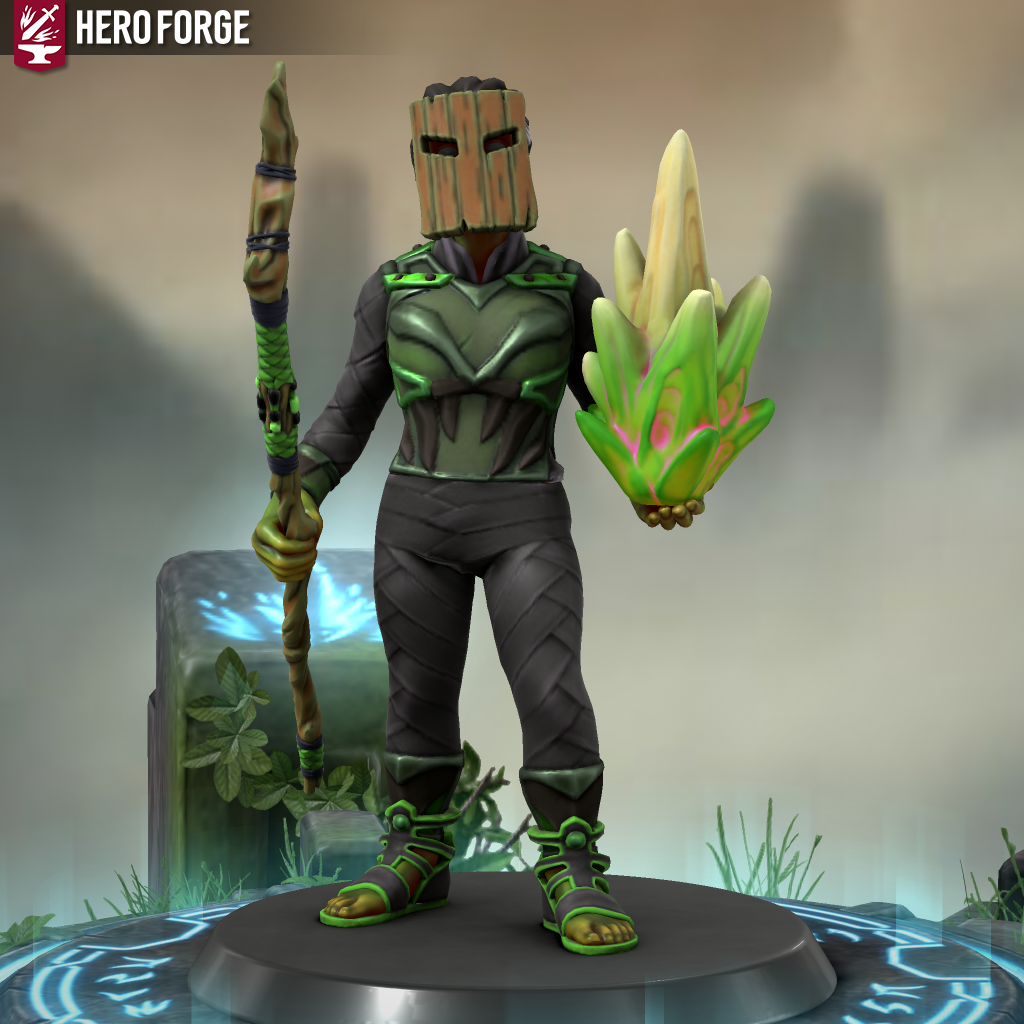The Blight
When the awakened plants of dark, evil lands come alive, blights soon follow. Born of dead trees, originally, these naturally evil creatures stalk prey in packs, and advance bogs into other locations, turning life into dull husks of their former selves. In recent times though, necromancers on the side of good have been able to great a Cleansed variation of these creatures. These creatures offer guides to traversing forests, defence against plants, and basic medicine training to most people that wish to learn. They continue their creator's work, down to the most minute of details, to ensure goodness, or evil, lingers on wherever they live.
Physical Description
Blight are made of plants and the earth. Some blights resemble a woody shrub, others a needled tree, and other a grouping of vines. Some are more humanoid than others, and they range widely in size depending on their subrace. Their beginnings are from evil, but their fate is not. It is said that the wooden stake driven through the body of a vile vampire was the start of it all. It was infused with the blood of that dreaded monster, and from that stake, a tree grew with the help of an ancient druidic circle, manifested from dark powers of an Archfey. From that tree, seeds were produced that in turn produced the first Blights. And so for many years, Blights were looked on as evil defilers of natural lands, corrupting entire ecosystems to the will of their long-lost benefactor, and slaying any natural, unaligned being within their path. That was until a minor nature deity came along. He rid the forest of all evil until he came upon the tree from which all the Blights were born. Despite all his power, he could not destroy the tree, and so instead sought to cleanse it. In his success, he created the first tree to bear the seeds of the altered variation of the blight. Instead of causing nature to decay, it had aided the decaying, and shifted them into altered, yet prospering variations of their former selves. Some believe that Treants originate from this process as well.Society
Blight live in tightly knit communities centralized around the Gulthias Tree from which they were spawned. As seedlings, they are confined to the place at which they first sprouted until they are strong enough to remove themselves from the ground. Often, a group of seedlings are purposely planted in the same area so that they can all be taught together. Once a seedling detaches themselves from the ground, they become a Sproutling, and though now mobile, they cannot sustain themselves away from the forest in which their Gulthias Tree resides. Only once they reach adulthood can they venture beyond that forest. A rare few Blights have learned enough common to communicate effectively, although blights are not intelligent, they do have the potential for scholastic development. For their good counterparts, they often intermingle with Dryad communities, and some even venture off to isolated areas in forests, or elven kingdoms.Blight Names
As Blights originated not from evolution, but a curse, they hold no true names, heritages, or honour in their ancestors. Names are hard to find from Blights, although when they are closer to a group of people, they are often given a name.Height and Weight Chart
Needle Blight
| Base Height | Height Modifier | Base Weight | Weight Modifier |
| 4'5 | 2d8'' | 95 lbs | x (1d4) lbs |
Twig Blight
| Base Height | Height Modifier | Base Weight | Weight Modifier |
| 2'7 | + 1d8'' | 25 lbs | x (1d4) lbs |
Blight Traits
These plants are often created by magic but usually their form determines their abilities and alignment.Flora Anatomy. Your creature type is plant, rather than humanoid. You are vulnerable to fire damage.
Take Root. You can sink your roots down into the earth as a bonus action. While rooted, you have advantage on saving throws made against effects that would knock you prone or forcefully move you. If you fail a save against an effect that knocks you prone or forcefully moves you, you are unrooted. Your speed becomes 0 while rooted, and you can't benefit from any bonus to speed. Uprooting yourself takes a bonus action.
Tremorsense. While rooted, you have tremorsense out to a range of 30 feet.
False Appearance. While you are rooted, remain motionless, and aren't wearing armor, you have advantage on Dexterity (Stealth) and Charisma (Deception) checks to be mistaken for a normal plant.
Ability Score Increase. Your Wisdom score increases by 2 and your Intelligence score is decreased by 2.
Age. Blights are Seedlings until the age of 15 and Sproutlings until the age of 35, at which point they are considered adults. They have no age limit but at some point, typically 500-600 years, they decide to find at least two of their brethren (so as to have all three Cleansed subraces), undergo a week-long ritual to merge and take permanent root to become a new Gulthias Tree. They can also decide not to merge but still take permanent roots, allowing themselves to become normal plants.
Alignment. Blights are almost always Neutral Evil; however, a minority have recently taken to more neutral manners of action. When Cleansed, they often become Neutral Good.
Size. Blights vary in size. While most Blights are a size comparable to humans, occasionally some are much smaller or much larger.
Speed. Your base walking speed is 25 feet.
Languages. You can speak, Common and Elvish; however, can read and write neither.
Subrace. Pick a subrace, between two options; Needle or Twig.
Needle
Ability Score Increase. Your Constitution score increases by 1.Size. Your size is Medium.
Needle Throw. You can use your action to fire the needles covering your body. Make a ranged attack roll. On a hit, the target takes piercing damage equal to 2d6 + your Dexterity modifier. This attack has a normal range of 20 feet and a long range of 60 feet. You can use this trait a number of times equal to your Constitution modifier (minimum of once). You regain all expended uses when you finish a long rest.
Natural Magic. You know the druidcraft cantrip. When you reach 3rd level, you can cast the goodberry spell once with this trait and regain the ability to do so when you finish a long rest. When you reach 5th level, you can cast the speak with plants spell once with this trait and regain the ability to do so when you finish a long rest. Wisdom is your spellcasting ability for these spells and none of these spells require material components.
Twig
Ability Score Increase. Your Dexterity score increases by 1.Size. Your size is Small.
Natural Claws. Your unarmed strikes deal 1d4 slashing damage on a hit. Naturally Stealthy. You can attempt to hide even when you are only lightly obscured by foliage, heavy rain, falling snow, mist, other natural phenomena, or a creature at least one size larger than you. Natural Magic. You know the mold earth cantrip. When you reach 3rd level, you can cast the longstrider spell once with this trait and regain the ability to do so when you finish a long rest. When you reach 5th level, you can cast the pass without trace spell once with this trait and regain the ability to do so when you finish a long rest. When you cast this spell using this feature it does not require concentration. Wisdom is your spellcasting ability for these spells and none of these spells require material components.




Fascinating character you're building here with powerful abilities. I especially like "take root" as an ability!